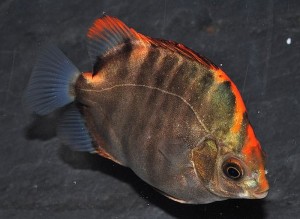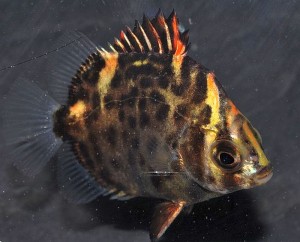The Red Scat (Scatophagus argus arromaculatus) is found in muddy coastal areas and is found only in Sri Lanka, New Guinea, and Australia. They live in estuaries, harbors, around mangroves and in the lower courses of rivers where the waters are brackish to marine in salinity.
There are two color morphs of Scatophagus argus which are both popular with tropical fish keeping enthusiasts. The common Spotted or Green Scat (Scatophagus argus), and the Ruby or Red Scat (Scatophagus argus arromaculatus).
The Red Scat (Scatophagus argus arrowmaculatus) is also known to tropical fish keeping enthusiasts as the Read headed Scat or Ruby Red Scat and during the late 1960s and 70s, Scats were also called the “poor man’s discus.”
Scatophagus argus, are basically bronze in color, marked with numerous small brown or black spots on the body flanks.
As the fish mature, the spots on the body become darker, the bronze become brassier in hue, and their spots become little less distinct, especially on the lower half of the body.
A gradual change from brackish water to saltwater will maximize the colors of the fish as they become older and improve their general health and well being.
The Red Scat has a strongly compressed body with a steep dorsal head profile and a rounded snout, with red blotches along the dorsal surface of their body, particularly on the top part of the head and below the dorsal fin.
As the fish matures it develops a more humped back.
The Hooghly River scat closely resembles normal Scatophagus argus, but the dark blotches on the flanks are larger and often merge into short bands.
Red, or Ruby Red Scats need an aquarium of at least 125 gallons with plenty of plants and places to hide. Although they can be kept in fresh water, they do best in a brackish water environment with 3 to 4 teaspoons of sea salt per 2.5 gallons of water. Choose plants that thrive in brackish water environments.
Scatophagus argus arromaculatus can adapt to varying salinities. As fry, they are found in freshwater, but as they mature they move into saltwater environments and eventually into the ocean to spawn. They do not live in temperate waters. To date not much is known about sexing the Red Scat or their breeding habits.
Red Scats are indiscriminate eaters and were named for their purported habit of feeding on offal. As juveniles, they seem to prefer zoo plankton in their diet but as adults they are primarily herbivores.
In an aquarium environment they should be fed mainly vegetable based foods with occasional offerings of meaty foods. Fresh, frozen or freeze dried seaweed, lettuce, algae, a quality flake food and occasionally brine shrimp will keep them healthy.
The Red Scat is readily available to tropical fish keeping enthusiasts and are sold as juveniles between 1″ and 2″ in length.
Minimum Tank Size: 125 gallons
Care Level: Moderate
Temperament: Peaceful
Aquarium Hardiness: Moderately Hardy
Water Conditions: 68-82° F, KH 8-12, pH 7.5-8.5
Max. Size: 12″
Color Form: Tan, Yellow, Red
Diet: Omnivore
Compatibility: Multiple species brackish water tank
Origin: Sri Lanka, New Guinea, and Australia
Family: Scatophagidae
Lifespan: 20 years
Aquarist Experience Level: Advanced




